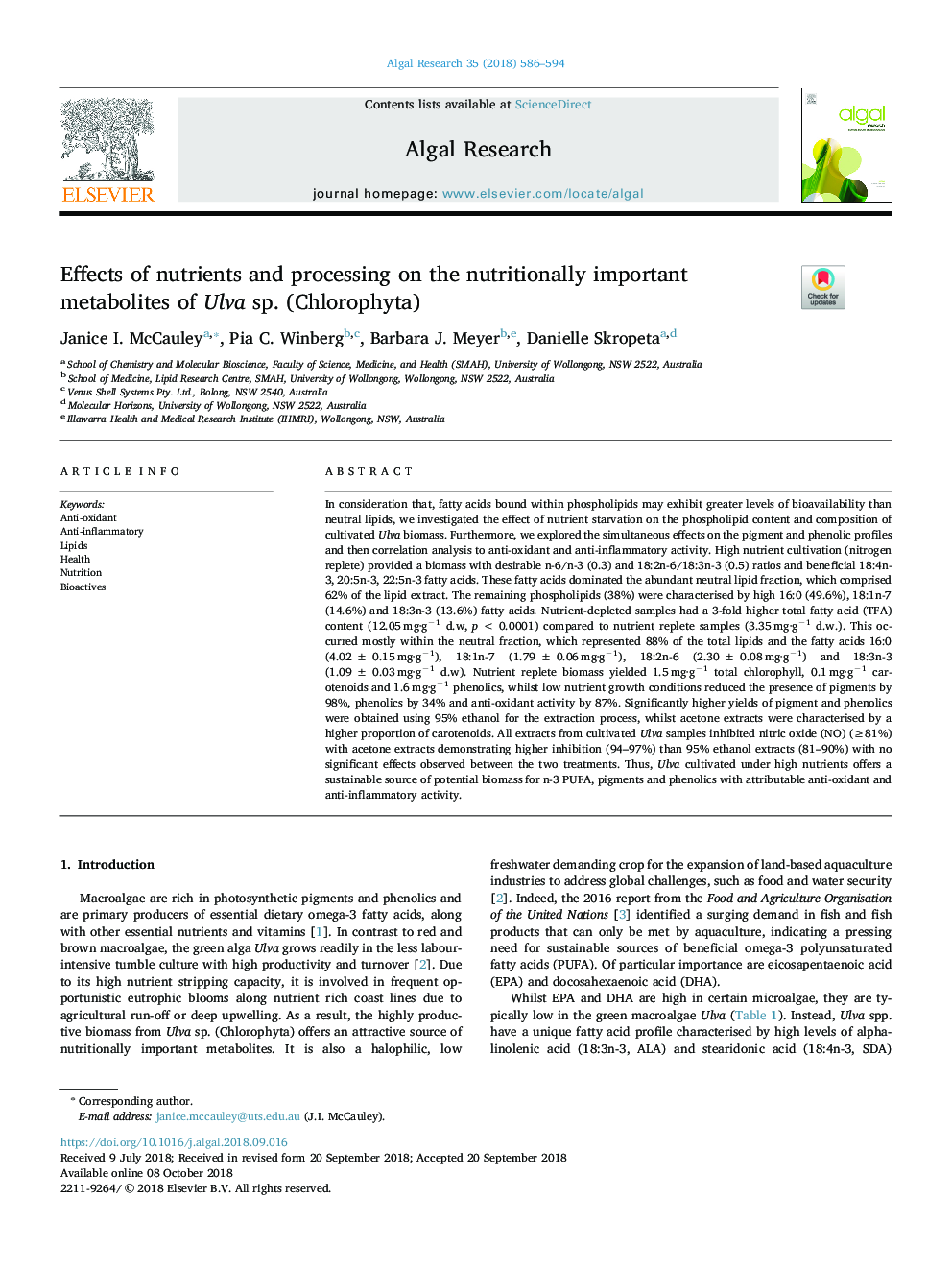| کد مقاله | کد نشریه | سال انتشار | مقاله انگلیسی | نسخه تمام متن |
|---|---|---|---|---|
| 11032770 | 1645149 | 2018 | 9 صفحه PDF | دانلود رایگان |
عنوان انگلیسی مقاله ISI
Effects of nutrients and processing on the nutritionally important metabolites of Ulva sp. (Chlorophyta)
دانلود مقاله + سفارش ترجمه
دانلود مقاله ISI انگلیسی
رایگان برای ایرانیان
کلمات کلیدی
موضوعات مرتبط
مهندسی و علوم پایه
مهندسی انرژی
انرژی های تجدید پذیر، توسعه پایدار و محیط زیست
پیش نمایش صفحه اول مقاله

چکیده انگلیسی
In consideration that, fatty acids bound within phospholipids may exhibit greater levels of bioavailability than neutral lipids, we investigated the effect of nutrient starvation on the phospholipid content and composition of cultivated Ulva biomass. Furthermore, we explored the simultaneous effects on the pigment and phenolic profiles and then correlation analysis to anti-oxidant and anti-inflammatory activity. High nutrient cultivation (nitrogen replete) provided a biomass with desirable n-6/n-3 (0.3) and 18:2n-6/18:3n-3 (0.5) ratios and beneficial 18:4n-3, 20:5n-3, 22:5n-3 fatty acids. These fatty acids dominated the abundant neutral lipid fraction, which comprised 62% of the lipid extract. The remaining phospholipids (38%) were characterised by high 16:0 (49.6%), 18:1n-7 (14.6%) and 18:3n-3 (13.6%) fatty acids. Nutrient-depleted samples had a 3-fold higher total fatty acid (TFA) content (12.05â¯mg·gâ1 d.w, pâ¯<â¯0.0001) compared to nutrient replete samples (3.35â¯mg·gâ1 d.w.). This occurred mostly within the neutral fraction, which represented 88% of the total lipids and the fatty acids 16:0 (4.02â¯Â±â¯0.15â¯mg·gâ1), 18:1n-7 (1.79â¯Â±â¯0.06â¯mg·gâ1), 18:2n-6 (2.30â¯Â±â¯0.08â¯mg·gâ1) and 18:3n-3 (1.09â¯Â±â¯0.03â¯mg·gâ1 d.w). Nutrient replete biomass yielded 1.5â¯mg·gâ1 total chlorophyll, 0.1â¯mg·gâ1 carotenoids and 1.6â¯mg·gâ1 phenolics, whilst low nutrient growth conditions reduced the presence of pigments by 98%, phenolics by 34% and anti-oxidant activity by 87%. Significantly higher yields of pigment and phenolics were obtained using 95% ethanol for the extraction process, whilst acetone extracts were characterised by a higher proportion of carotenoids. All extracts from cultivated Ulva samples inhibited nitric oxide (NO) (â¥81%) with acetone extracts demonstrating higher inhibition (94-97%) than 95% ethanol extracts (81-90%) with no significant effects observed between the two treatments. Thus, Ulva cultivated under high nutrients offers a sustainable source of potential biomass for n-3 PUFA, pigments and phenolics with attributable anti-oxidant and anti-inflammatory activity.
ناشر
Database: Elsevier - ScienceDirect (ساینس دایرکت)
Journal: Algal Research - Volume 35, November 2018, Pages 586-594
Journal: Algal Research - Volume 35, November 2018, Pages 586-594
نویسندگان
Janice I. McCauley, Pia C. Winberg, Barbara J. Meyer, Danielle Skropeta,